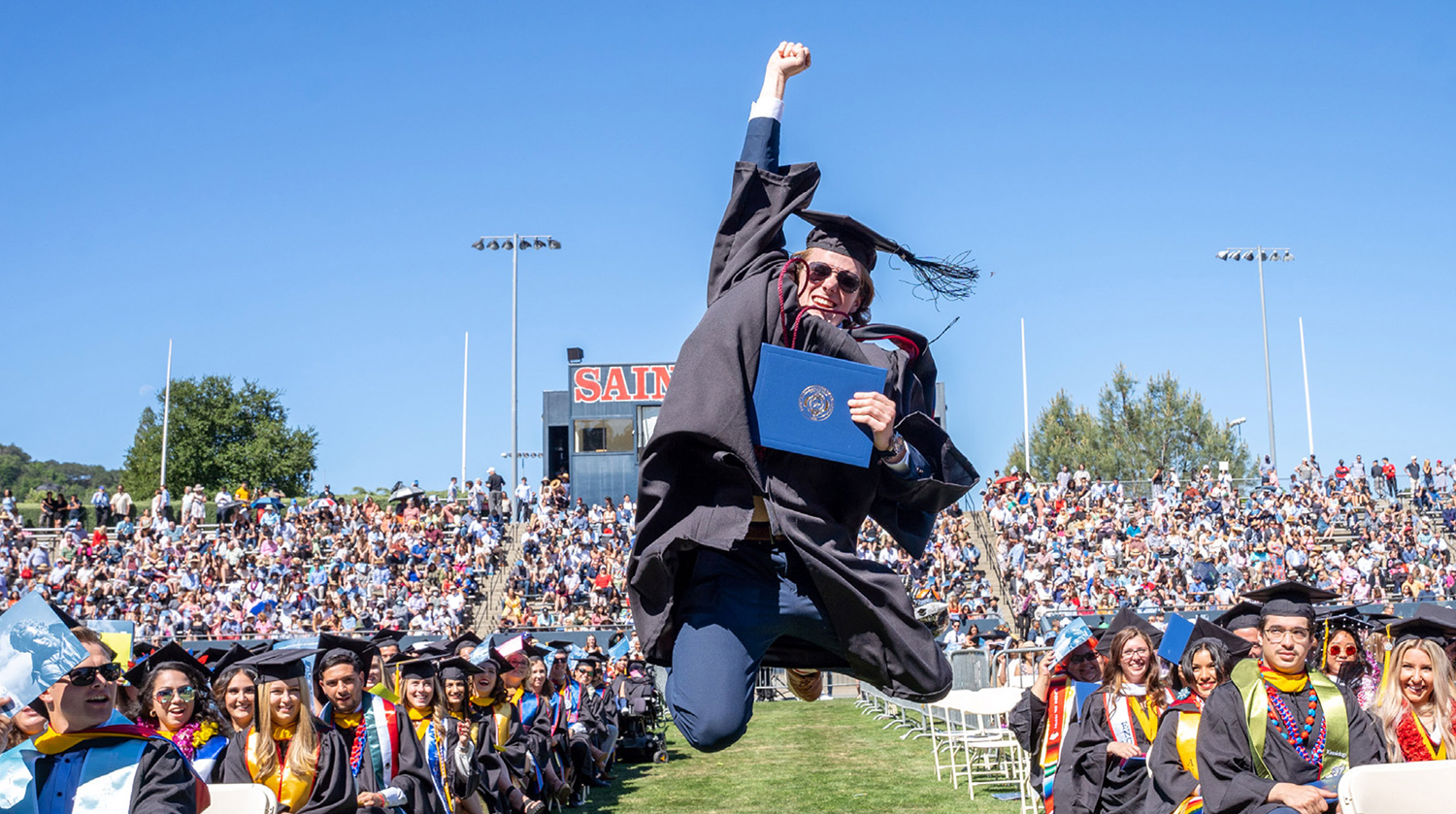Saint Mary's College Strategic Plan

Mission Statement
Grounded in its Lasallian, Catholic, and liberal arts heritage, Saint Mary’s College is a student-centered learning community committed to transformative, equitable, and inclusive teaching, the passionate pursuit of knowledge, and expansive access to a practical education that empowers students to make lasting change in the world.

Vision Statement
Saint Mary’s College will become a leading innovative, national Catholic university that inspires minds, touches hearts, and transforms lives.
Where We Are Now
Prioritized initiatives were adopted by Fall 2023, and each initiative has been tracked for progress since then. The first annual report was issued in Summer 2024.
Foundations
The Transformation 2028 strategic plan builds on our legacy, recognizes the landscape facing us and rests upon four foundations.

Ensure the College’s financial stability and sustaining our mission and propelling it into the future.

Deepen our commitment to our Lasallian Catholic and Liberal Arts heritage.

Advance diversity, equity, inclusion, and belonging across our campus community.

Exhibit leadership in social justice education, research, and advocacy.
Opportunities
Through extensive conversation and community input, we have arrived at six core opportunities to guide us into our 2028 centennial celebration. These opportunities will allow us to remain rooted in the essential vision and values of Saint Mary’s College while emboldening us to flourish.

Reimagine, redesign and reinvent Saint Mary’s identity as a liberal arts institution.
First, we will reimagine, redesign and reinvent Saint Mary’s identity as a liberal arts institution. We are a Lasallian, Catholic, liberal arts comprehensive university with a national reputation and global reach. As we press forward, we will leverage our legacy to offer a broad array of exceptional in-demand programs—undergraduate, graduate, professional, and continuing education—that prepare our graduates to make a meaningful difference in their lives, careers, and the wider world

Empower diverse learners to succeed at Saint Mary’s and beyond.
Second, as we consider our responsibility to our students, we will empower diverse learners to succeed at Saint Mary’s and beyond. We will throw open doors for more students, especially those from underrepresented communities. In the coming years, we will create more opportunities for individuals of diverse backgrounds to access higher education, to thrive as part of a transformative academic experience, and remain connected long after graduation day.

Embrace a creative and innovative spirit.
Third, to accomplish our goals, we must embrace a creative and innovative spirit. Saint Mary’s instills inventive thinking and deft problem-solving within our students. The same should be true of our institution. We will become ever more adaptable and nimble in response to the challenges and opportunities in our systems, processes, and organizational strategies.

Cultivate a dynamic, collaborative work culture and environment.
Fourth, we will continue to cultivate a dynamic, collaborative work culture and environment. When John Baptist de La Salle first invited his teachers to live in his home in 1681, he modeled the associative dynamism of community, a culture that continues to sustain Lasallian institutions today. We may not all live in the same home, but Saint Mary’s will carry on the legacy of life lived together. We will build a dynamic, collaborative, and high-functioning work environment and continue to attract and retain exceptional, diverse faculty and staff. This work will help us sustain an inclusive and generous campus community.

Position our campus as a connected local and global hub.
Fifth, our future success depends, in large part, on our ability to position our campus as a connected local and global hub. Saint Mary’s assets are numerous: an advantageous location in the San Francisco Bay Area, our distinctive built and natural environment, a rich heritage and unique character, and our cohesive community. Moving forward, we will synthesize all of these features to become an epicenter, deepening our connections with students, families, alumni, friends, and the surrounding community.

Advance our leadership in environmental justice and sustainability
And sixth, moving forward, it is imperative that we advance our leadership in environmental justice and sustainability. Drawing on the global Lasallian commitment to sustainability and Pope Francis’ encyclical “Laudato Si,” Saint Mary’s will lean into our core values of equity, justice, and inclusion. During the next six years and beyond, we will better equip our students to tackle the most pressing environmental problems. Simultaneously, we will transform the built campus environment into a living laboratory for equitable and sustainable solutions.
Strategic Priorities
In addition to our guiding themes, we have determined eleven strategic priorities to pursue during the next five years. With these strategic priorities, we are defining our transformation. We will set our sights on 2028, seeking initiatives that widen our impact and opportunities that propel us into an abundant future.

EXTEND OUR REACH AND EXPAND OUR IMPACT. See Goals

LAUNCH INNOVATIVE AND IN-DEMAND ACADEMIC PROGRAMS. See Goals

EMPOWER ALL STUDENTS FOR SUCCESS AT SAINT MARY'S AND BEYOND. See Goals

INCREASE ACCESS, AFFORDABILITY, AND EQUITY. See Goals

ATTRACT AND RETAIN AN EXCEPTIONAL AND DIVERSE FACULTY AND STAFF. See Goals

BECOME A THRIVING AND ADAPTIVE LEARNING ORGANIZATION. See Goals

DEVELOP SAINT MARY'S AS A HUB IN THE BAY AREA. See Goals

POSITION SAINT MARY'S AS A GLOBAL CAMPUS. See Goals

INVEST IN THE CAMPUS AND WELCOME INTERNAL AND EXTERNAL AUDIENCES. See Goals

FULFILL SAINT MARY'S CLIMATE ACTION PLAN. See Goals

ACHIEVE FINANCIAL HEALTH AND GROWTH. See Goals
